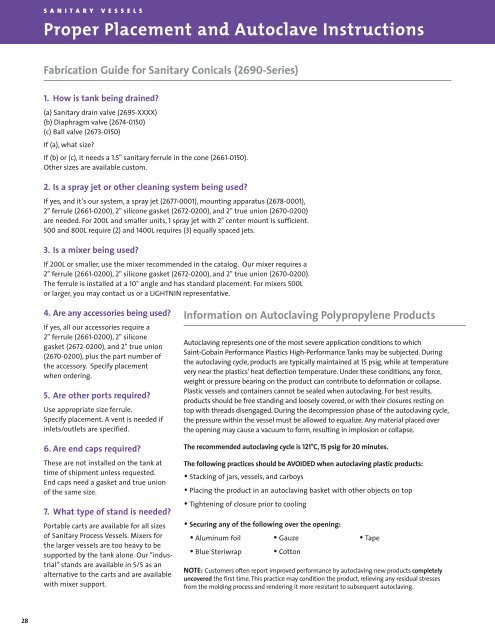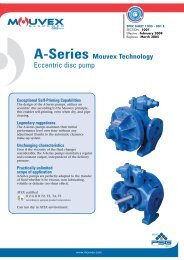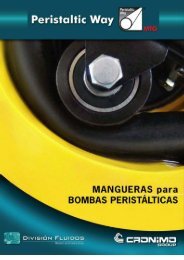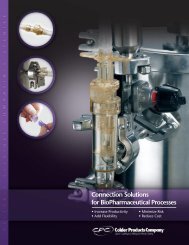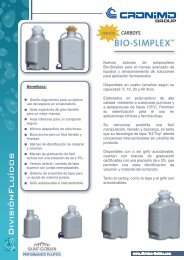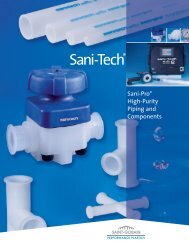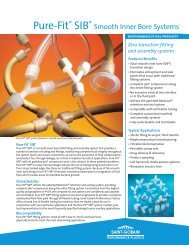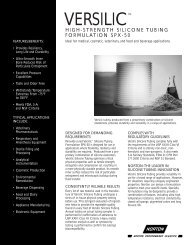Sanitary Tanks
Sanitary Tanks
Sanitary Tanks
You also want an ePaper? Increase the reach of your titles
YUMPU automatically turns print PDFs into web optimized ePapers that Google loves.
S A N I TAR Y V E S S E L SProper Placement and Autoclave InstructionsFabrication Guide for <strong>Sanitary</strong> Conicals (2690-Series)1. How is tank being drained?(a) <strong>Sanitary</strong> drain valve (2695-XXXX)(b) Diaphragm valve (2674-0150)(c) Ball valve (2673-0150)If (a), what size?If (b) or (c), it needs a 1.5" sanitary ferrule in the cone (2661-0150).Other sizes are available custom.2. Is a spray jet or other cleaning system being used?If yes, and it’s our system, a spray jet (2677-0001), mounting apparatus (2678-0001),2" ferrule (2661-0200), 2" silicone gasket (2672-0200), and 2" true union (2670-0200)are needed. For 200L and smaller units, 1 spray jet with 2" center mount is sufficient.500 and 800L require (2) and 1400L requires (3) equally spaced jets.3. Is a mixer being used?If 200L or smaller, use the mixer recommended in the catalog. Our mixer requires a2" ferrule (2661-0200), 2" silicone gasket (2672-0200), and 2" true union (2670-0200).The ferrule is installed at a 10° angle and has standard placement. For mixers 500Lor larger, you may contact us or a LIGHTNIN representative.4. Are any accessories being used?If yes, all our accessories require a2" ferrule (2661-0200), 2" siliconegasket (2672-0200), and 2" true union(2670-0200), plus the part number ofthe accessory. Specify placementwhen ordering.5. Are other ports required?Use appropriate size ferrule.Specify placement. A vent is needed ifinlets/outlets are specified.6. Are end caps required?These are not installed on the tank attime of shipment unless requested.End caps need a gasket and true unionof the same size.7. What type of stand is needed?Portable carts are available for all sizesof <strong>Sanitary</strong> Process Vessels. Mixers forthe larger vessels are too heavy to besupported by the tank alone. Our “industrial”stands are available in S/S as analternative to the carts and are availablewith mixer support.Information on Autoclaving Polypropylene ProductsAutoclaving represents one of the most severe application conditions to whichSaint-Gobain Performance Plastics High-Performance <strong>Tanks</strong> may be subjected. Duringthe autoclaving cycle, products are typically maintained at 15 psig, while at temperaturevery near the plastics’ heat deflection temperature. Under these conditions, any force,weight or pressure bearing on the product can contribute to deformation or collapse.Plastic vessels and containers cannot be sealed when autoclaving. For best results,products should be free standing and loosely covered, or with their closures resting ontop with threads disengaged. During the decompression phase of the autoclaving cycle,the pressure within the vessel must be allowed to equalize. Any material placed overthe opening may cause a vacuum to form, resulting in implosion or collapse.The recommended autoclaving cycle is 121°C, 15 psig for 20 minutes.The following practices should be AVOIDED when autoclaving plastic products:• Stacking of jars, vessels, and carboys• Placing the product in an autoclaving basket with other objects on top• Tightening of closure prior to cooling• Securing any of the following over the opening:• Aluminum foil• Blue Steriwrap• Gauze• Cotton• TapeNOTE: Customers often report improved performance by autoclaving new products completelyuncovered the first time. This practice may condition the product, relieving any residual stressesfrom the molding process and rendering it more resistant to subsequent autoclaving.28


